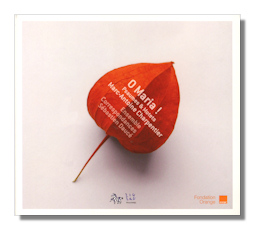
The Internet's Premier Classical Music Source
Related Links
-
Charpentier Reviews
De La Guerre Reviews - Latest Reviews
- More Reviews
-
By Composer
-
Collections
DVD & Blu-ray
Books
Concert Reviews
Articles/Interviews
Software
Audio
Search Amazon
Recommended Links
Site News
 CD Review
CD Review
Marc-Antoine Charpentier

O Maria!
Psaumes et Motets
- In odorem unguentorum, H 51
- Prélude pour ce qu'on voudra, H 521
- Gratiarum actiones pro restituta regis christistianissimi sanitate anno 1686, H 341
- Beati omnes qui timent Dominum, H 178
- O sacramentum pietatis, H 274
- Pie Jesu, H 427
- Super flumina Babylonis, H 170
- Supplicatio pro defunctis, H 328
- Magdalena lugens, H 343
- Elisabeth Jacquet de La Guerre: Sonata in D minor
Ensemble Correspondances/Sébastien Daucé
Zig-Zag Territories ZZT100601
This is a superb CD of psalm settings and sacred motets in honor of the Virgin Mary by Baroque composer Marc-Antoine Charpentier (1643-1704) with a sonata by Elisabeth Jacquet de La Guerre (1665-1729). The performance by the dozen-strong Ensemble Correspondances directed by Sébastien Daucé on the ever-enterprising Zig-Zag Territoires label in association with the Foundation Orange, a support fund for bringing on new vocal performers, cannot be recommended too highly for capturing, interpreting and then re-presenting the very essence of Charpentier, and his close, intense milieu.
The first thing that is likely to strike the listener is the gentle, stately, yet far from pompous pace of these pieces. By allowing them space and by fostering an unhurried, calm and focused presentation (listen to the pauses and cadences in Super flumina Babylonis (H 170) [tr.6], for example) the devotional intent of Charpentier is emphasized… it's as though we are involved in the occasions for which the music was first written and following his every reason for writing as he did. It's indeed illuminating playing and singing.
Also prominent is the way in which Ensemble Correspondances (three singers and nine instrumentalists) shows off Charpentier's spectacular use of counterpoint; though never in an ostentatious way. Like all other aspects of the composer's approach to such commissions (much of what we hear on this CD was written for the Hôtel de Guise), the text is of great importance; the music supports and underlines it in every way. The performances that result from such a firm and deep understanding of Charpentier's idiom on the part of Daucé do much to communicate what Charpentier would surely have wished for… clear diction, clean melodic lines, delicate and roseate harmonies, unfussy continuo; and a rich yet transparent texture.
The Latin as sung is, of course, a very French, very Baroque Latin. Whether or not you're used to this, it quickly becomes natural and itself adds to the impact of the music in that its intensity and warmth re-inforce the relationship which worshippers of Charpentier's time had with their religious models and figures. This was an intimate yet public, raw yet respectful, one. Another balance which this music strikes is that between veneration and inspiration on the one hand; and overtly positive and very human musical expression on the other. In the Supplicatio pro defunctis (H 328) [tr.10], for instance, the singers (and players) of Ensemble Correspondances are singing at your elbow; but their efforts are humbly directed outwards to the object of their veneration.
The Sonata [tr.7] is as somber and thoughtful as the rest of the music here. But far from lugubrious. Fittingly staid and restrained. Modeled on the sonatas of Corelli, it is nevertheless as French as the music of Charpentier himself. And included here as a foil and potential contrast to the sonatas which Charpentier wrote, the first French composer to do so.
The booklet that comes with the CD is informative and contains the texts in Latin, French and English. Its commentary would make a good brief introduction to Charpentier's world in general, as well as the particularities of this sublime music, no one piece of which lasts muh more than eight minutes – yet into each of which is packed so much. The acoustic is not over-resplendent, thus allowing the listener to concentrate on the enunciation, phrasing and projection of the singers and players and thereby the better to appreciate the warm and intense world of Charpentier. Since only a couple of these pieces are available elsewhere, this is a CD to be snapped up immediately by all lovers of the repertoire; it's sure to please.
Copyright © 2011, Mark Sealey.





















